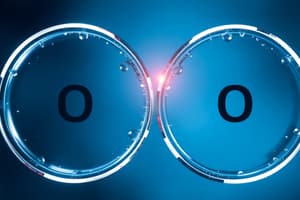Podcast
Questions and Answers
What are the 3 main bond types that can form between atoms?
What are the 3 main bond types that can form between atoms?
covalent, ionic, metallic
What chiefly determines the polarity of a bond?
What chiefly determines the polarity of a bond?
differences in electronegativity
Which kind of element forms covalent bonds? Give two reasons for this.
Which kind of element forms covalent bonds? Give two reasons for this.
nonmetals; they have high electronegativities and few valence electrons missing
What forces hold covalently bonded atoms together?
What forces hold covalently bonded atoms together?
How many valence electrons do most atoms seek to have after forming bonds?
How many valence electrons do most atoms seek to have after forming bonds?
Which seven elements occur as diatomic, covalent molecules?
Which seven elements occur as diatomic, covalent molecules?
What term describes the arrangement of particles in an ionic compound?
What term describes the arrangement of particles in an ionic compound?
Why are covalent bonds usually gases, liquids, or solids with low melting points?
Why are covalent bonds usually gases, liquids, or solids with low melting points?
Why do atoms form chemical bonds?
Why do atoms form chemical bonds?
Which bond type is distinctly different from the other two, and why?
Which bond type is distinctly different from the other two, and why?
There is no purely covalent bond.
There is no purely covalent bond.
There is no purely ionic bond.
There is no purely ionic bond.
Flashcards are hidden until you start studying
Study Notes
Bond Types
- Three main types of bonds: covalent, ionic, metallic.
Polarity of Bonds
- Polarity is determined chiefly by differences in electronegativity between atoms.
Covalent Bonds
- Formed primarily by nonmetals due to high electronegativities and because they are close to having full valence shells.
Forces in Covalent Bonds
- Covalently bonded atoms are held together by electrostatic forces.
Valence Electrons
- Most atoms aim for a full valence shell, typically seeking 8 electrons after bond formation.
Diatomic Molecules
- Seven elements that exist as diatomic molecules: Hydrogen, Nitrogen, Oxygen, Fluorine, Chlorine, Bromine, and Iodine; their arrangement resembles a "7" on the periodic table.
Ionic Compounds
- The arrangement of particles in ionic compounds is known as a crystal lattice.
Physical States of Covalent Bonds
- Covalent bonds generally lead to gases, liquids, or solids with low melting points due to weak intermolecular forces.
Reason for Chemical Bonds
- Atoms form chemical bonds to lower energy levels and achieve greater stability.
Distinct Bond Type
- Metallic bonds are unique as they involve a delocalization of electrons shared among many atoms.
Covalent Bonds
- There can be purely covalent bonds, depending on the electronegativity of the atoms involved.
Ionic Bonds
- Purely ionic bonds do not exist due to varying degrees of ionic character in all compounds.
Studying That Suits You
Use AI to generate personalized quizzes and flashcards to suit your learning preferences.



